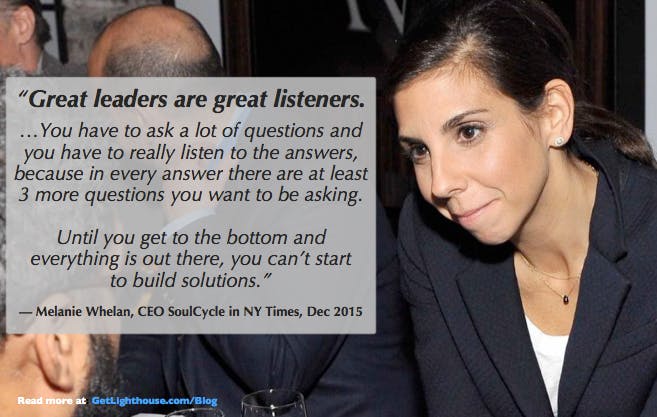In today’s edition, we cover a favorite book of mine that will really get you thinking about what matters most to you, we answer a great question about 1 on 1 questions, and talk about how to help your team build better bonds.
And then we also have a great tune up post on the Lighthouse blog to help you be more productive and effective as a leader.
Let’s dive in…
Table of contents:
- 🥘 Food for Thought on Removing Friction on Your Team
- 📚 Book of the Month on a Book for Reflection
- 🕰️ A Great Time to Share Your Leadership Secrets
- ❓ Ask Lighthouse on How to Use 1 on 1 Questions
Note: This is a preview of our weekly leadership newsletter, Lighthouse Leadership Weekly (LLW).
To get this sent to your inbox every week, along with our latest long form essays on this blog, you can sign up here.
🥘 Food for Thought
I loved this share from friend of Lighthouse, Mark C Crowley:
BRILLIANT Way To Foster #Connection:
— Mark C. Crowley (@MarkCCrowley) February 22, 2024
The CEO of $3.5b security company, Verkada, is letting employees expense up to $30 in food & drinks if they go out together after 3PM in groups of three or more.
The CEO is betting workers will pick each other’s brains & spark #innovation.
This is a great way to give your team an excuse to spend more time together. It's simple, easy to remember, and sets clear expectations for how it can be used.
In particular I like the following about it:
- $30 maximum: You can go get a few cheap beverages and a snack, or a light meal together with that much money, but no one is getting hammered drunk, nor expensing Tomahawk steaks at that rate. It's hard to abuse it, but enough to make it worthwhile. (Note: if you live in say NYC, you may need to make your equivalent $50. Verkada is in San Mateo, CA for comparison.)
- After 3PM: This ensures people are getting their work done instead of blowing off work to go hang out on the company's dime. It also frames the timing of it as socializing after most of the workday is complete.
- Groups of 3 or more: As we've shared recently, having a best friend at work is great, but only ~20% of workers have one. Even if you do, by requiring a 3rd person, it brings new people into the fold and makes it easy for two work best friends to see who's around to ask to join them, building new bonds, instead of going off on their own.
Now, if you're reading this, you may not be the person who makes a budget call for something like this. It might be a good idea to suggest it, but let's not leave today's lesson rely on the hope of getting the same benefit at your company.
The Real Question: How do you lower the friction for your team to foster connections, bond, and create more serendipity on your team?
One of the best things you can do as a leader is help your team build bonds and work better together. A team that enjoys each other's company and cares about each other will always crush the team that hates each other, no matter how good the skills of everyone is individually on the latter team.
So what can you do? Try a few of these things:
- Plan occasional events to help foster work friendships: Team lunches, post work social outings, fun events during a work/team retreat, and hackathons are all ways that people can build friendships at work. If you're not sure which to do, try asking your team; what they'd enjoy doing may be different than other teams, and that's okay. The key is to do something people want to join in for.
- Help your team have more collisions: Steve Jobs helped design Pixar's office specifically to ensure people randomly ran into each other. These "collisions" help breed innovation as people share ideas and learn what other people are up to, help solve problems, and unintentionally connect.
- If you're in an office at least some days each week, make sure your team sit near each other and are in on the same days. This maximizes the odds of collisions.
- If you're all remote, consider how often you can bring people together in person, and in the meantime, encourage more small talk and intentional connections. (More detailed advice in #4 here)
- Lead the way creating rapport and psychological safety: As we often say at Lighthouse, nothing is more powerful than the example you set. No, you aren't trying to be friends with your direct reports (that creates other problems), but in showing an interest in them as unique humans, and creating psychological safety, you create an environment for everyone else to get to know each other and take an interest in one another.
What are good, creative examples you've seen to help encourage team members to build bonds and spend quality time together?
Share your favorite tactic and I'll include the best ones in the newsletter next week.
📚 Book of the Month on a Book for Reflection
We've been on a pretty heavy "How to" run of books for the Book of the Month lately; from planning your year with the 12 Week Year to how to run a great team with The Score Takes Care of Itself and High Output Management, they are very practical tactical books specifically written with managers and high performers in mind.
That's why this month, as we head into a new quarter and spring time in the Northern Hemisphere, we're going with a different kind of book, that is also one of my favorites:

How will you measure your life? by Clayton Christensen
The late Harvard professor, Clayton Christensen, lived an interesting life, teaching, writing, and studying innovation (he literally wrote the best-selling book, "The Innovator's Dilemma"). Yet, I think one of his most valuable contributions was this book.
What's interesting is that Clayton went to Harvard himself in addition to teaching there. It gave him a birds eye view of many highly educated, "successful" people.
I put successful in quotes, because in many ways the book is a sobering take. He goes into great detail on not just what he thinks helped him be successful, but what he saw in his peers. When he saw many of them at reunions, he would notice who had ugly divorces, who had failed businesses, and even who was going to jail.
It's a great book to help zoom out from the day to day and really look at what's important to you in your life.
For some people that sort of reflection doesn't happen until they have a near-death experience, get diagnosed with cancer, or lose a loved one.
With spring upon us and the change of seasons, it's a great time for you to reflect on changes you want to make in your life.
>> You can get your copy of How Will You Measure Your Life here.
❓ Ask Lighthouse on How many questions should you ask in your 1 on 1s?
A reader wrote in with a great question:
"I just read your article on questions for 1:1 (for the 3rd time 😅) and I have a problem…I think they are all great questions!!
Do you have any tips on how many questions we should use in a 1:1? 1 from each? 2? I want to know all of the answers, but I don’t want it to feel like a ‘third degree’ :)"
This is a great question I see often from eager managers. They see our post with over 100 questions to ask in your 1 on 1s and want to ask them all right away.
But that's not the ideal approach. In reality, you only want 2-3 of the questions *total* per 1 on 1.

One question, many answers.
The former CEO of SoulCycle has a fantastic insight here that we quoted above. The key part is the second half of the quote:
"...in every answer there are at least 3 more questions you want to be asking.
Until you get to the bottom and everything is out there, you can start to build solutions."
That's the key. Any of those questions in our post will help you learn interesting things from your team, but you shouldn't stop there.
Instead, you should ask follow up and clarifying questions to really fully and deeply understand them.
An example in action:
Let's say you're just getting to know a new team member, so you're using one of our rapport building questions:
- Do you have any pets? How long have you had them?
As you can see, we already gave you the second question to ask. Assuming they do have a pet or two, there are a bunch of easy, obvious follow up questions to ask:
- What are their names? (write this down so you can ask about them later)
- How long have you had them?
- What made you choose that pet?
- What's your favorite part about having them as a pet?
- And if you've never had a pet like that and it's exotic, you can ask things like, What's it like taking care of them? What do they need?
The point is, you show you have genuine interest in what they have to say by asking some follow up questions. You also better understand their unique situation.
For example, with pets, you'll now know who may be barking in the background on a call, or if the pet is old, you'll know to keep an eye out for if the pet passes away (crushing for especially their young family members).
And you can do the same for more serious topics like their career goals, feedback about work habits, coaching them, etc.
It's also why Curiosity is one the most underrated skills for managers to learn.
So if you need to get better at asking questions:
- Check out our post with over 150 questions you can ask in your 1 on 1s
- Learn more about mastering the skill of asking questions and being curious
- And if you are managing a brand new team, start with these 6 essential questions
Addendum: Sometimes a question doesn't resonate.
Maybe they don't have a pet, the way you asked it or our wording from the post is strange to them.
Regardless, that's why you bring a 2-3 questions with you. That way you can try asking it a few ways, or move onto a different topic. All you need to do is hit on one thing they're excited to talk about and the followup questions will easily fill the time you have in a single 1 on 1, and give the benefit of improved rapport with your team member.
Then, all you have to do is rinse and repeat.
🕰️ A Great Time to Share Your Leadership Secrets
If you read this newsletter, you're ahead of the curve. You're the kind of manager who is proactive; you seek out opportunities to learn and grow, building your skills as a leader faster than most.
That's a surefire way to stand out at work.
I love hearing the stories many of you have shared about getting promoted partially thanks to implementing what we write and talk about at Lighthouse.
Yet, getting promoted comes with its own challenges.
Now, you have a team that reports to you, that now also has direct reports, too. Or maybe you even have a whole organization now many layers deep.
🙋 Are they all as proactive as you?
As a manager or other managers, what are you doing to help them grow?
Just because you may have been on your own to learn to lead doesn't mean your team should be. In fact, you should set a different example for them and help and support them.
😫 But how do you do that?!?
With your promotions comes more meetings, more responsibility, and more stress.
Who has time to create a detailed growth plan and find material for each of your managers?
This is *exactly* what Lighthouse Lessons: Group Edition was designed for, and many senior leaders and executives use us for.
Group Training for Leaders who Care.
Our programs are the ideal solution for your busy schedule and under-trained managers. We give you:
- Lighthouse quality content: If you've read this newsletter and our blog for long, you know we work hard to always bring a mix of research, data, how-tos, and actionable advice. Lighthouse Lessons is just like that, only better, because it's focused on a topic you care about like coaching, servant leadership, 1 on 1s, or leadership habits.
- Bite-size for busy managers: You and your team have enough on your plate. You don't need a week off of work to have some training fly through PowerPoints 8 hours a day. Instead, we give you ~15 minute lessons, once per week, so anyone can fit it in their work life.
- Action, action, action: We know the best learning and biggest impact comes from actually applying what you learn which is why every lesson, starting with lesson 1, has you applying it to you and your team. See results from week 1.
- Grow as a Group: A key part of the group edition is the weekly meeting you have to discuss the lessons. We provide an agenda that you can literally open 30 seconds before the meeting and have an amazing discussion. Managers rave about the impact, because they're who helped us develop it:

- Leave YOUR Mark: While we're providing the content and discussion questions, YOU leave your mark by both choosing which of our 8 programs is the right fit for your managers, and we set up the discussions so you'll be prompted to share your perspective with your managers so they know what you want to see and what fits your unique culture.
So what are you waiting for? Your managers won't become great leaders without your help.
Learn about our many programs to choose from and sign up to start training your group here: https://m.getlighthouse.com/team-training
Thanks to everyone who responded last week with your biggest challenges. It's helpful for us to know new topics to cover here and on our blog, and some of the questions will be answered in future Ask Lighthouse sections as well.
If you haven't responded yet and would like to, reply and share your biggest leadership challenge right now.
Thanks,
Jason
PS: There are more ways for you to learn:
- If a friend sent this to you, sign up here to get this newsletter every Saturday morning: https://getlighthouse.ck.page/9aa103e62f
- Want to learn about building great products with a style similar to this newsletter? Check out my Practical Product newsletter here.
- Groups of 10 or more managers can take Lighthouse Lessons courses any time. Learn more and sign up your group here.
Sign up to get this newsletter & our latest blog posts straight to your inbox:




